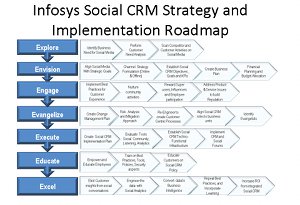
Strategies for Smooth Social CRM Implementation, Part 1
Based on an empirical study carried out on Fortune 1000 organizations’ social CRM initiatives, a 7-E framework has been developed for a Social CRM strategy and implementation road map.
This “Vision to Value” road map can be logically split into two approaches: Strategic, which includes the phases Explore, Envision, Evaluate and Evangelize; and Implementation, which includes Execute, Empower, Engage and Excel.
Road Map to Success
Explore: The first and foremost task for any organization looking to align social media with business objectives is to do a competitor and customer analysis — unless your customers are not active on social media, in which case it does not make much sense to invest heavily in it.
Understanding, measuring and controlling success and risk factors is the foundation of a successful social CRM strategy. This phase emphasizes assessing the fit of social media with the business through the following key activities:
- Understand your social customer’s behavior and rank the customer segments based on participation, influence and interest;
- Identify and prioritize the functions, customer segments, and product types that warrant social media adoption; and
- Analyze and understand your competitors’ social media footprint.
Envision: Every organization must assess the business need for social media and social CRM initiatives before taking the plunge. It is imperative that social media be considered a channel to attain the broader organization-level strategic direction and goals, rather than a “nice to have” means of reaching customers. Formulating a strategy that maps the organization’s goals with social media activities is a key step of the Envision phase.
Establishing strategies to cross-leverage social media activities for offline business efforts is also key to a streamlined integrated social CRM implementation. Most Fortune 500 organizations that have reported successful returns and benefits from social CRM initiatives have aligned efforts to attain the larger corporate goals and establish cross-leverages between online and offline operations.
For instance, Dell and Starbucks generate product ideas along with customers through their idea-generation communities — later developing popular product ideas and taking them to market.
Engage: Merely improving presence on social media will not reap benefits to the organization. The engagement of customers and employees using this medium is what will provide actionable insights. The social conversations, once analyzed using listening tools, should provide input to the CRM system that will generate leads and service requests.
Similarly, organizations’ productivity can be improved by different functional teams — as when Sales use social media for real-time collaboration.
Evangelize: This is at the crux of the desired goals for a social CRM initiative. A change management plan needs to be drafted in order to identify the extent of re-engineering that customer-oriented processes will require. Social CRM scenarios should be aligned with the latest customer experience dynamics.
Execute: Choosing an established partner to successfully manage the transition of the organization from CRM 1.0 to CRM 2.0 is paramount. Creating and executing an implementation plan, and establishing the right technical infrastructure to empower employees and meet customer-oriented objectives are key to the success of the social CRM initiative.
Like any other project, social CRM initiatives also require risk identification, assessment and mitigation mechanisms from people, process, policy and technology perspectives. Creating owners, influencers, moderators, facilitators and super-users for the social forums, communities and blogs is a major milestone to be accomplished during this phase.
The key pieces involved in a social CRM implementation are the choice of social media, social listening tools, social CRM packages, and social analytics. Based on the budget and complexity of functional requirements, the choice of product will vary.
Educate: The importance of managing change in mindset and organizational culture cannot be overemphasized. Social CRM calls for a paradigm shift in the approach to customers and thereby requires a robust change management plan for successful execution.
The key activities in this phase are changes in employee skill sets and organizational culture to service shifting customer expectations. It is also imperative to establish mechanisms, policies and guidelines to manage brand perception and sentiments.
For banks and financial institutions that constantly have the added responsibility of regulatory compliance, validity of the information/identity or authentication of the social customer that banks are transacting or conversing with becomes mandatory. KYC and AML checks for leads generated from social media need to be further modified and tightened to mitigate any identify theft or fraud risks.
Excel: Elicit actionable information, business intelligence and customer insights from conversations on social media. Measuring these conversations in terms of volume, sentiment, topic of conversation, ratings, preferences, and friends and followers is feasible with analytics tools currently available in the market.
First Mover Advantage
Contrary to the common belief, it is possible and proven that social media ROI is tangible. In addition to the most-cited examples of Dell’s sales of US$4 million via social media and Comcast’s significant savings on support costs, the marketplace is beginning to see many significant tangible and intangible benefits being reported by Fortune 1000 organizations that have embraced social CRM.
The result is not just an engaged customer base, but also an engaged workforce that is genuinely motivated keep the customers happy — catapulting the organization toward excellence and increased market share.
The secret to successful customer engagement lies not in making ALL customers happy, but being transparent with customers when required, and building trust in every transaction and conversation that occurs on the social Web. With the advent of multichannel synchronization in customer interactions, a customer expects to receive preferential treatment on the Web, phone, and branch.
Keeping a unified view of the customer in CRM applications with deep insight into the customer’s level of activity and influence in varied channels plays a key role in formulating a profitable customer segmentation, acquisition, retention and relationship strategy. Tracking and management of the social conversations and profile of the customer in traditional CRM applications, therefore, is more a necessity than a luxury to establish a successful social strategy in the organization.
A well-defined social CRM adoption and implementation strategy is bound to move the organization successfully from traditional CRM 1.0 to progressive and evolutionary CRM 2.0. Social CRM is here to stay, and the organizations that have jumped onto the bandwagon intelligently and effectively have already established their first mover advantage.



































Social Media
See all Social Media